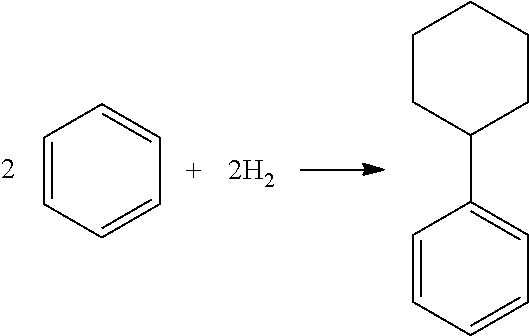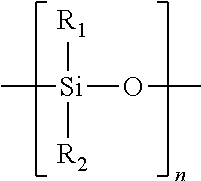Hydroalkylation of aromatic compounds using EMM-12
a technology of aromatic compounds and hydroalkylation, which is applied in the direction of hydrocarbon by addition and hydrogenation, physical/chemical process catalysts, bulk chemical production, etc., can solve the problems of large quantity of unwanted by-products and low selectivity to cyclohexylbenzen
- Summary
- Abstract
- Description
- Claims
- Application Information
AI Technical Summary
Benefits of technology
Problems solved by technology
Method used
Image
Examples
example 1
Preparation of EMM-12
[0124]A sample of EMM-10-P (3 g) made according to Example 1 of U.S. patent application Ser. No. 11 / 823,129 was added to the mixture of 30 g of 1 M nitric acid and 0.5 g of diethoxydimethylsilane. The reaction was carried out in a teflon container sealed in a Parr™ bomb in the oven at 170° C. for 24 hrs. The solid product of EMM-12 was isolated by filtration, washed and dried at 120° C.
[0125]The XRD pattern of the solid product of EMM-12 is characterized as comprising a doublet at between 12.45 and 13.60 Angstroms, corresponding to 6.5-7.1° 2θ (Cu Kα) and non-discrete scattering between 8.85 to 11.05 Angstroms, the 8-10° 2θ (Cu Kα) region or exhibit a valley in between the peaks at 11.05±0.18 and 9.31±0.13 Angstroms but with measured intensity corrected for background at the lowest point being not less than 50% of the point at the same XRD d-spacing on the line connecting maxima at around 11.05±0.18 and 9.31±0.13 Angstroms.
[0126]The calcined product of EMM-12 ha...
example 2
Preparation of EMM-12
[0127]A sample of EMM-10-P (3 g) made according to Example 1 of U.S. patent application Ser. No. 11 / 823,129 was added to the mixture of 30 g of 1 M nitric acid. The reaction was carried out in a teflon container sealed in a Parr™ bomb in the oven at 170° C. for 24 hrs. The solid product of EMM-12 was isolated by filtration, washed and dried at 120° C.
[0128]The XRD pattern of the solid product of EMM-12 is characterized as comprising a doublet at between 12.45 and 13.60 Angstroms, corresponding to 6.5-7.1° 2θ (Cu Kα) and non-discrete scattering between 8.85 to 11.05 Angstroms, the 8-10° 2θ (Cu Kα) region or exhibit a valley in between the peaks at 11.05±0.18 and 9.31±0.13 Angstroms but with measured intensity corrected for background at the lowest point being not less than 50% of the point at the same XRD d-spacing on the line connecting maxima at around 11.05±0.18 and 9.31±0.13 Angstroms.
[0129]The calcined product of EMM-12 has high surface area of 471 m2 / g and ...
example 3
[0130]The filtered, washed and dried samples of Examples 1 and 2 were combined, exchanged with 1 N ammonium nitrate and calcined at 540° C. in air to convert the composite sample to the H-form of EMM-12.
[0131]Benzene was obtained from a commercial source. The benzene was passed through a pretreatment vessel containing equal parts (by volume) molecular sieve 13X, molecular sieve 4A, Engelhard F-24 Clay, and Selexsorb CD (in order from inlet to outlet), and then through a pretreatment vessel containing MCM-22 catalyst. All feed pretreatment materials were dried in a 260° C. oven for 12 hours before using.
[0132]Nitrogen was ultra high purity grade and obtained from a commercial specialty gases source.
PUM
| Property | Measurement | Unit |
|---|---|---|
| pressure | aaaaa | aaaaa |
| temperature | aaaaa | aaaaa |
| molar ratio | aaaaa | aaaaa |
Abstract
Description
Claims
Application Information
 Login to View More
Login to View More - R&D
- Intellectual Property
- Life Sciences
- Materials
- Tech Scout
- Unparalleled Data Quality
- Higher Quality Content
- 60% Fewer Hallucinations
Browse by: Latest US Patents, China's latest patents, Technical Efficacy Thesaurus, Application Domain, Technology Topic, Popular Technical Reports.
© 2025 PatSnap. All rights reserved.Legal|Privacy policy|Modern Slavery Act Transparency Statement|Sitemap|About US| Contact US: help@patsnap.com



